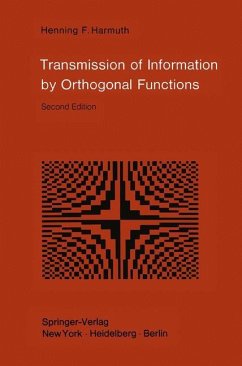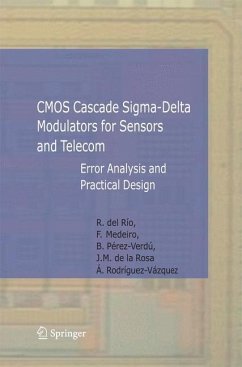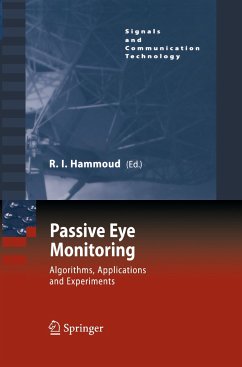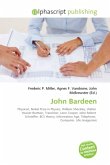Henning F. Harmuth
Transmission of Information by Orthogonal Functions
Henning F. Harmuth
Transmission of Information by Orthogonal Functions
- Broschiertes Buch
- Merkliste
- Auf die Merkliste
- Bewerten Bewerten
- Teilen
- Produkt teilen
- Produkterinnerung
- Produkterinnerung
The orthogonality of functions has been exploited in communications since its very beginning. Conscious and extensive use was made of it by Kotel'nikov in theoretical work in 1947. Ten years later a considerable number of people were working in this field. However, little experimental use could be made of the theoretical results before the arrival of solid state operational amplifiers and integrated circuits. The advantages of Walsh functions, which are emphasized in this book, were recognized independently by several scientists in the early sixties. Among them were E. Gibbs, K. Henderson,…mehr
Andere Kunden interessierten sich auch für
![Cognitive Radio, Software Defined Radio, and Adaptive Wireless Systems Cognitive Radio, Software Defined Radio, and Adaptive Wireless Systems]() Cognitive Radio, Software Defined Radio, and Adaptive Wireless Systems110,99 €
Cognitive Radio, Software Defined Radio, and Adaptive Wireless Systems110,99 €![CMOS Cascade Sigma-Delta Modulators for Sensors and Telecom CMOS Cascade Sigma-Delta Modulators for Sensors and Telecom]() Rocío Río FernándezCMOS Cascade Sigma-Delta Modulators for Sensors and Telecom110,99 €
Rocío Río FernándezCMOS Cascade Sigma-Delta Modulators for Sensors and Telecom110,99 €![Passive Eye Monitoring Passive Eye Monitoring]() Passive Eye Monitoring110,99 €
Passive Eye Monitoring110,99 €![Impact Of Information And Communication Technology Impact Of Information And Communication Technology]() Janet IsokaImpact Of Information And Communication Technology38,99 €
Janet IsokaImpact Of Information And Communication Technology38,99 €![Handbuch für die Telekommunikation Handbuch für die Telekommunikation]() Handbuch für die Telekommunikation109,99 €
Handbuch für die Telekommunikation109,99 €![Active Sensor Planning for Multiview Vision Tasks Active Sensor Planning for Multiview Vision Tasks]() Shengyong ChenActive Sensor Planning for Multiview Vision Tasks116,99 €
Shengyong ChenActive Sensor Planning for Multiview Vision Tasks116,99 €![John Bardeen John Bardeen]() John Bardeen22,99 €
John Bardeen22,99 €-
-
-
The orthogonality of functions has been exploited in communications since its very beginning. Conscious and extensive use was made of it by Kotel'nikov in theoretical work in 1947. Ten years later a considerable number of people were working in this field. However, little experimental use could be made of the theoretical results before the arrival of solid state operational amplifiers and integrated circuits. The advantages of Walsh functions, which are emphasized in this book, were recognized independently by several scientists in the early sixties. Among them were E. Gibbs, K. Henderson, F.Ohnsorg, G. Sandy and E. Vandivere, whose work was not published until many years later. Somewhat more than half the illustrations in this second edition were not contained in the first edition and this reflects the changes in contents. The most striking difference between the two editions is the progress toward practical applications made in the intervening three years. However, it may turn out that the most important change is one that appears rather theoretical on the surface and that concerns shift-invariant features strongly connected with sine-cosine functions. These functions are projections of the exponential function which, in turn, is the character group of the real numbers. The topology of the real numbers is generally accepted to be the same as that of time or a one-dimensional space, and this is the basis for a variety of claims that sinusoidal functions are unique and superior to all others.
Produktdetails
- Produktdetails
- Verlag: Springer / Springer Berlin Heidelberg / Springer, Berlin
- Artikelnr. des Verlages: 978-3-642-61976-2
- 2. Aufl.
- Seitenzahl: 408
- Erscheinungstermin: 6. November 2011
- Englisch
- Abmessung: 235mm x 155mm x 23mm
- Gewicht: 615g
- ISBN-13: 9783642619762
- ISBN-10: 3642619762
- Artikelnr.: 36118483
- Verlag: Springer / Springer Berlin Heidelberg / Springer, Berlin
- Artikelnr. des Verlages: 978-3-642-61976-2
- 2. Aufl.
- Seitenzahl: 408
- Erscheinungstermin: 6. November 2011
- Englisch
- Abmessung: 235mm x 155mm x 23mm
- Gewicht: 615g
- ISBN-13: 9783642619762
- ISBN-10: 3642619762
- Artikelnr.: 36118483
Historical Background and Motivation for the Use of Nonsinusoidal Functions 1.- Orthogonal Functions, Walsh Functions and Other Basic Mathematical Concepts 3.- Filtering of Time and Space Signals 6.- Direct and Carrier Transmission of Signals 6.- Nonsinusoidal Electromagnetic Waves 7.- Statistical Theory of Communication 8.- 1. Mathematical Foundations.- 1.1 Orthogonal Functions.- 1.1.1 Orthogonality and Linear Independence.- 1.1.2 Series Expansion by Orthogonal Functions.- 1.1.3 Invariance of Orthogonality to Fourier Transformation.- 1.1.4 Walsh Functions.- 1.1.5 Hadamard Matrices and General Two-Valued Functions.- 1.1.6 Haar Functions and General Three-Valued Functions.- 1.1.7 Functions with Several Variables.- 1.2 Generalized Fourier Analysis.- 1.2.1 Transition from Fourier Series to Fourier Transform.- 1.2.2 Generalized Fourier Transform.- 1.2.3 Invariance of Orthogonality to the Generalized Fourier Transform.- 1.2.4 Examples of the Generalized Fourier Transform.- 1.2.5 Fast Walsh-Fourier Transform.- 1.2.6 Fast Haar-Fourier Transform.- 1.2.7 Generalized Laplace Transform.- 1.2.8 Dyadic Differentiation, Integration and Correlation.- 1.3 Generalized Frequency.- 1.3.1 Physical Interpretation of the Generalized Frequency.- 1.3.2 Power Spectrum, Amplitude Spectrum, Filtering of Signals.- 1.3.3 Examples of Walsh-Fourier Transforms and Power Spectra.- 1.3.4 Dyadic Time.- 2. Sequency Filters for Time and Space Signals.- 2.1 Correlation Filters for Time Signals.- 2.1.1 Generation of Time Variable Walsh Functions.- 2.1.2 Sequency Low-Pass Filters.- 2.1.3 Sequency Band-Pass Filters.- 2.1.4 Multiplicity Filters and Asynchronous Filters.- 2.2 Resonance Filters for Time Signals.- 2.2.1 Series and Parallel LCS Resonance Filters.- 2.2.2 Low-Pass LCS Resonance Filters.- 2.2.3 Parametric Amplifiers.- 2.3 Instantaneous Filters for Space Signals.- 2.3.1 Filters for Signals with One Space Variable.- 2.3.2 Filters for Signals with Two Space Variables.- 2.3.3 Practical Implementation of Filters for Signals with Two Space Variables.- 2.3.4 Filters for Signals with Three Space Variables.- 2.4 Sampling Filters for Space Signals.- 2.4.1 Generators for Space Variable Walsh Functions.- 2.4.2 Sampling in Two or Three Space Dimensions by Block Pulses and Walsh Functions.- 2.4.3 Sampling Filters and Displays for Signals with Two or Three Space Variables.- 2.5 Digital Sequency Filters.- 2.5.1 Filters Based on the Generalized Fourier Transform.- 2.5.2 Filters Based on Difference Equations.- 3. Direct Transmission of Signals.- 3.1 Orthogonal Division as Generalization of Time and Frequency Division.- 3.1.1 Representation of Signals.- 3.1.2 Examples of Signals.- 3.1.3 Amplitude Sampling and Orthogonal Decomposition.- 3.2 Practical Problems of Transmission.- 3.2.1 Circuits for Orthogonal Division.- 3.2.2 Transmission of Digital Signals by Sine and Cosine Pulses.- 3.2.3 Conversion of Sequency Limited Signals into Frequency Limited Signals.- 3.3 Characterization of Communication Channels.- 3.3.1 Frequency Response of Attenuation and Phase Shift of a Communication Channel.- 3.3.2 Characterization of a Communication Channel by Crosstalk Parameters.- 4. Carrier Transmission of Signals.- 4.1 Amplitude Modulation (AM).- 4.1.1 Modulation and Synchronous Demodulation.- 4.1.2 Correction of Time Differences in Synchronous Demodulation.- 4.1.3 Methods of Single Sideband Modulation.- 4.2 Multiplexing of Time Variable Signals.- 4.2.1 Multiplex Systems.- 4.2.2 Examples of Mixed Sequency-Frequency Multiplex Systems.- 4.2.3 Digital Multiplexing.- 4.3 Time Base, Time Position and Code Modulation.- 4.3.1 Time Base Modulation (TBM).- 4.3.2 Time Position Modulation (TPM).- 4.3.3 Code Modulation (CM).- 5. Nonsinusoidal Electromagnetic Waves.- 5.1 Dipole Radiation of Walsh Waves.- 5.1.1 Hertzian Dipole Solution of Maxwell's Equations.- 5.1.2 Near Zone-Wave Zone Effect.- 5.1.3 Magnetic Dipole Radiation.- 5.1.4 Implementation of Radiators.- 5.2 Multipole Radiation of Walsh Waves.- 5.2.1 Radiation of a One-Dimensional Quadrupole.- 5.2.2 Radiation of a Two-Dimensional Quadrupole.- 5.2.3 Multipole Radiation.- 5.3 Interference Effects, Doppler Effect.- 5.3.1 Radiation Diagram of a Row of Spherical Radiators.- 5.3.2 Doppler Effect.- 5.3.3 Circular Polarization, Interferometry, Shape Recognition.- 5.4 Signal Selection and Synchronization.- 5.4.1 Separation of Signals in Mobile Communication.- 5.4.2 Synchronous Reception of Walsh Waves.- 6. Application of Orthogonal Functions To Statistical Problems.- 6.1 Series Expansion of Stochastic Functions.- 6.1.1 Thermal Noise.- 6.1.2 Statistical Independence of the Components of an Orthogonal Expansion.- 6.2 Additive Disturbances.- 6.2.1 Least Mean Square Deviation of a Signal from Sample Functions.- 6.2.2 Examples of Circuits.- 6.2.3 Matched Filters.- 6.2.4 Compandors for Sequency Signals.- 6.3 Multiplicative Disturbances.- 6.3.1 Interference Fading.- 6.3.2 Diversity Transmission Using Many Copies.- 7. Signal Design for Improved Reliability.- 7.1 Transmission Capacity.- 7.1.1 Measures of Bandwidth.- 7.1.2 Transmission Capacity of Communication Channels.- 7.1.3 Signal Delay and Signal Distortions.- 7.2 Error Probability of Signals.- 7.2.1 Error Probability of Simple Signals due to Thermal Noise.- 7.2.2 Peak Power Limited Signals.- 7.2.3 Pulse-Type Disturbances.- 7.3 Coding.- 7.3.1 Coding with Binary Elements.- 7.3.2 Orthogonal, Transorthogonal and Biorthogonal Alphabets.- 7.3.3 Coding for Error-Free Transmission.- 7.3.4 Ternary Combination Alphabets.- 7.3.5 Combination Alphabets of Order 2r + 1.- References.
Historical Background and Motivation for the Use of Nonsinusoidal Functions 1.- Orthogonal Functions, Walsh Functions and Other Basic Mathematical Concepts 3.- Filtering of Time and Space Signals 6.- Direct and Carrier Transmission of Signals 6.- Nonsinusoidal Electromagnetic Waves 7.- Statistical Theory of Communication 8.- 1. Mathematical Foundations.- 1.1 Orthogonal Functions.- 1.1.1 Orthogonality and Linear Independence.- 1.1.2 Series Expansion by Orthogonal Functions.- 1.1.3 Invariance of Orthogonality to Fourier Transformation.- 1.1.4 Walsh Functions.- 1.1.5 Hadamard Matrices and General Two-Valued Functions.- 1.1.6 Haar Functions and General Three-Valued Functions.- 1.1.7 Functions with Several Variables.- 1.2 Generalized Fourier Analysis.- 1.2.1 Transition from Fourier Series to Fourier Transform.- 1.2.2 Generalized Fourier Transform.- 1.2.3 Invariance of Orthogonality to the Generalized Fourier Transform.- 1.2.4 Examples of the Generalized Fourier Transform.- 1.2.5 Fast Walsh-Fourier Transform.- 1.2.6 Fast Haar-Fourier Transform.- 1.2.7 Generalized Laplace Transform.- 1.2.8 Dyadic Differentiation, Integration and Correlation.- 1.3 Generalized Frequency.- 1.3.1 Physical Interpretation of the Generalized Frequency.- 1.3.2 Power Spectrum, Amplitude Spectrum, Filtering of Signals.- 1.3.3 Examples of Walsh-Fourier Transforms and Power Spectra.- 1.3.4 Dyadic Time.- 2. Sequency Filters for Time and Space Signals.- 2.1 Correlation Filters for Time Signals.- 2.1.1 Generation of Time Variable Walsh Functions.- 2.1.2 Sequency Low-Pass Filters.- 2.1.3 Sequency Band-Pass Filters.- 2.1.4 Multiplicity Filters and Asynchronous Filters.- 2.2 Resonance Filters for Time Signals.- 2.2.1 Series and Parallel LCS Resonance Filters.- 2.2.2 Low-Pass LCS Resonance Filters.- 2.2.3 Parametric Amplifiers.- 2.3 Instantaneous Filters for Space Signals.- 2.3.1 Filters for Signals with One Space Variable.- 2.3.2 Filters for Signals with Two Space Variables.- 2.3.3 Practical Implementation of Filters for Signals with Two Space Variables.- 2.3.4 Filters for Signals with Three Space Variables.- 2.4 Sampling Filters for Space Signals.- 2.4.1 Generators for Space Variable Walsh Functions.- 2.4.2 Sampling in Two or Three Space Dimensions by Block Pulses and Walsh Functions.- 2.4.3 Sampling Filters and Displays for Signals with Two or Three Space Variables.- 2.5 Digital Sequency Filters.- 2.5.1 Filters Based on the Generalized Fourier Transform.- 2.5.2 Filters Based on Difference Equations.- 3. Direct Transmission of Signals.- 3.1 Orthogonal Division as Generalization of Time and Frequency Division.- 3.1.1 Representation of Signals.- 3.1.2 Examples of Signals.- 3.1.3 Amplitude Sampling and Orthogonal Decomposition.- 3.2 Practical Problems of Transmission.- 3.2.1 Circuits for Orthogonal Division.- 3.2.2 Transmission of Digital Signals by Sine and Cosine Pulses.- 3.2.3 Conversion of Sequency Limited Signals into Frequency Limited Signals.- 3.3 Characterization of Communication Channels.- 3.3.1 Frequency Response of Attenuation and Phase Shift of a Communication Channel.- 3.3.2 Characterization of a Communication Channel by Crosstalk Parameters.- 4. Carrier Transmission of Signals.- 4.1 Amplitude Modulation (AM).- 4.1.1 Modulation and Synchronous Demodulation.- 4.1.2 Correction of Time Differences in Synchronous Demodulation.- 4.1.3 Methods of Single Sideband Modulation.- 4.2 Multiplexing of Time Variable Signals.- 4.2.1 Multiplex Systems.- 4.2.2 Examples of Mixed Sequency-Frequency Multiplex Systems.- 4.2.3 Digital Multiplexing.- 4.3 Time Base, Time Position and Code Modulation.- 4.3.1 Time Base Modulation (TBM).- 4.3.2 Time Position Modulation (TPM).- 4.3.3 Code Modulation (CM).- 5. Nonsinusoidal Electromagnetic Waves.- 5.1 Dipole Radiation of Walsh Waves.- 5.1.1 Hertzian Dipole Solution of Maxwell's Equations.- 5.1.2 Near Zone-Wave Zone Effect.- 5.1.3 Magnetic Dipole Radiation.- 5.1.4 Implementation of Radiators.- 5.2 Multipole Radiation of Walsh Waves.- 5.2.1 Radiation of a One-Dimensional Quadrupole.- 5.2.2 Radiation of a Two-Dimensional Quadrupole.- 5.2.3 Multipole Radiation.- 5.3 Interference Effects, Doppler Effect.- 5.3.1 Radiation Diagram of a Row of Spherical Radiators.- 5.3.2 Doppler Effect.- 5.3.3 Circular Polarization, Interferometry, Shape Recognition.- 5.4 Signal Selection and Synchronization.- 5.4.1 Separation of Signals in Mobile Communication.- 5.4.2 Synchronous Reception of Walsh Waves.- 6. Application of Orthogonal Functions To Statistical Problems.- 6.1 Series Expansion of Stochastic Functions.- 6.1.1 Thermal Noise.- 6.1.2 Statistical Independence of the Components of an Orthogonal Expansion.- 6.2 Additive Disturbances.- 6.2.1 Least Mean Square Deviation of a Signal from Sample Functions.- 6.2.2 Examples of Circuits.- 6.2.3 Matched Filters.- 6.2.4 Compandors for Sequency Signals.- 6.3 Multiplicative Disturbances.- 6.3.1 Interference Fading.- 6.3.2 Diversity Transmission Using Many Copies.- 7. Signal Design for Improved Reliability.- 7.1 Transmission Capacity.- 7.1.1 Measures of Bandwidth.- 7.1.2 Transmission Capacity of Communication Channels.- 7.1.3 Signal Delay and Signal Distortions.- 7.2 Error Probability of Signals.- 7.2.1 Error Probability of Simple Signals due to Thermal Noise.- 7.2.2 Peak Power Limited Signals.- 7.2.3 Pulse-Type Disturbances.- 7.3 Coding.- 7.3.1 Coding with Binary Elements.- 7.3.2 Orthogonal, Transorthogonal and Biorthogonal Alphabets.- 7.3.3 Coding for Error-Free Transmission.- 7.3.4 Ternary Combination Alphabets.- 7.3.5 Combination Alphabets of Order 2r + 1.- References.








